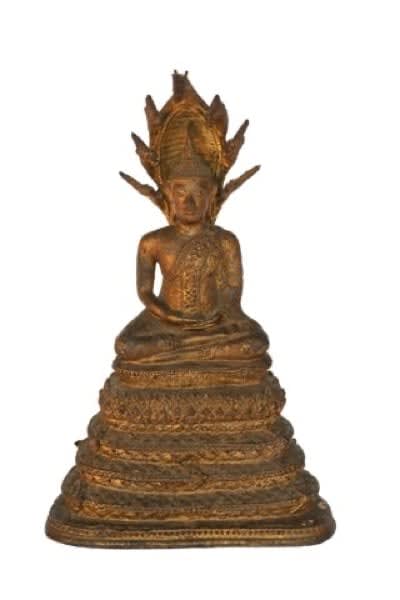Thai Buddha with Snake, 18th Century CE
height 28 cm
height 11 in
height 11 in
AB.019
It is said that one day as the enlightened Buddha was sitting in meditation, a great storm began, and it rained for seven days. Mucalinda, a naga (a divine or...
It is said that one day as the enlightened Buddha was sitting in meditation, a great storm began, and it rained for seven days. Mucalinda, a naga (a divine or semi-divine half-serpent being), came up to earth and protected the Buddha from the elements, using his coils and hood to shelter him from the rain. This sculpture captures a moment often represented in Buddhist iconography: the Buddha sitting peacefully in a meditative pose while being protected by Mucalinda. The snake’s coils form the base upon which the Buddha is sitting, and its seven heads rise above the Buddha and fan out from behind his own head. The coils are highly decorated with layers of patterns. The Buddha’s robes are also embellished, with raised dots across the surface and a stripe of floral motifs coming across his left shoulder and down his chest.
The Buddha sits in a meditative half-lotus pose, with his right hand resting upon his left in the Dhyana mudra. ‘Mudra’ literally means ‘seal’ or ‘gesture’ and is used to refer to a pose, usually of the hands, which has a symbolic meaning and connection to an event in the life of the Buddha. The Dhyana mudra is the gesture associated with meditation. His serene expression, with closed eyes and a relaxed face, show that he is able to retain his inner peace despite the storm happening around him. Other physical features, such as the rounded ushnisha, act as identifiers which mark this figure out as the Buddha and remind us of his life story. The ushnisha is a rounded protuberance on the top of the Buddha’s head, and it symbolises his enlightenment. On top of the ushnisha in this example we see a flame, a common addition which represents spiritual illumination. The extended earlobes visible here are another important attribute of the Buddha. Within East Asian belief, particularly Buddhism, large ears are seen as a sign of wisdom and compassion. The Buddha is often depicted with elongated ears to symbolise his ability to hear the cries of those who are suffering, and his sympathy and willingness to help ease their pain. It is therefore a comforting image, as it reminds those who see it that there is hope for an end to their sufferings through the search for enlightenment and the compassion of those who have reached it.
The Buddha sits in a meditative half-lotus pose, with his right hand resting upon his left in the Dhyana mudra. ‘Mudra’ literally means ‘seal’ or ‘gesture’ and is used to refer to a pose, usually of the hands, which has a symbolic meaning and connection to an event in the life of the Buddha. The Dhyana mudra is the gesture associated with meditation. His serene expression, with closed eyes and a relaxed face, show that he is able to retain his inner peace despite the storm happening around him. Other physical features, such as the rounded ushnisha, act as identifiers which mark this figure out as the Buddha and remind us of his life story. The ushnisha is a rounded protuberance on the top of the Buddha’s head, and it symbolises his enlightenment. On top of the ushnisha in this example we see a flame, a common addition which represents spiritual illumination. The extended earlobes visible here are another important attribute of the Buddha. Within East Asian belief, particularly Buddhism, large ears are seen as a sign of wisdom and compassion. The Buddha is often depicted with elongated ears to symbolise his ability to hear the cries of those who are suffering, and his sympathy and willingness to help ease their pain. It is therefore a comforting image, as it reminds those who see it that there is hope for an end to their sufferings through the search for enlightenment and the compassion of those who have reached it.
